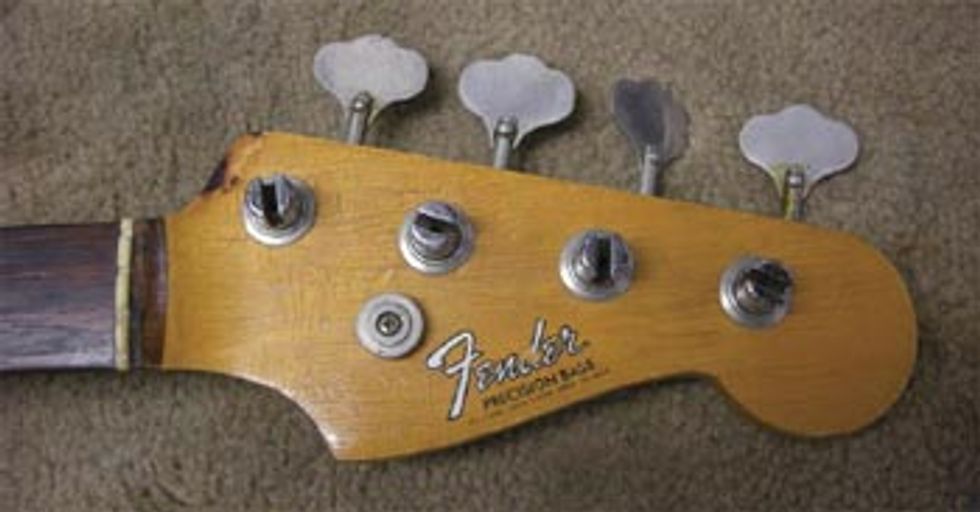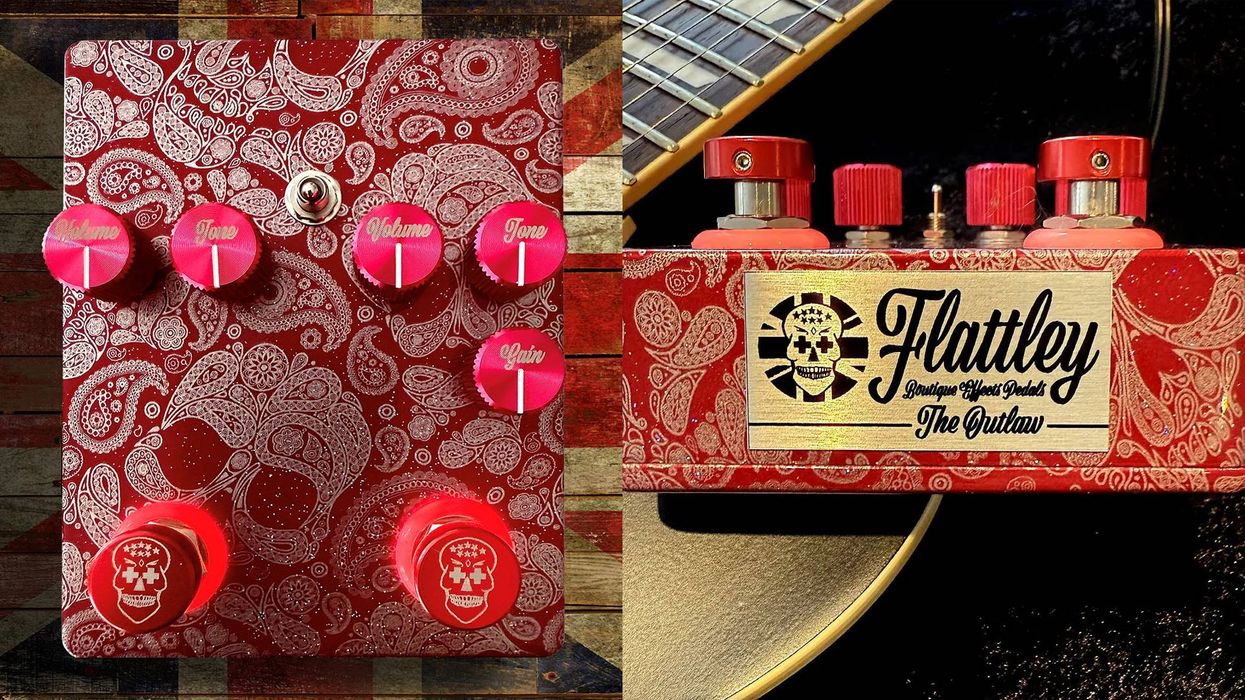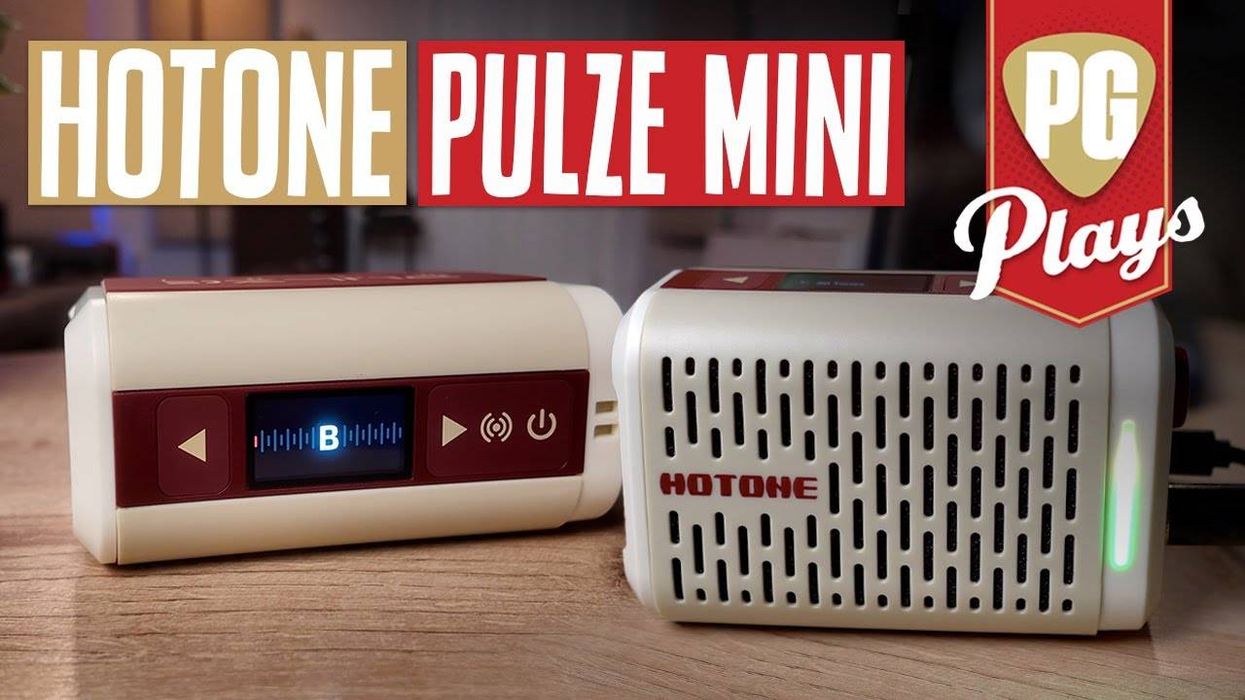Last month, we looked at anomalies from Rickenbacker, Gibson and Fender. This month, we’ll explore some Fender bass oddities and misconceptions. Ninety-five percent of weird things we see are done post-factory, so if you’re not sure, see a trained professional.
Let’s explore a few inconsistencies with vintage Fender bass finishes. Have you ever seen an original sunburst finished bass where the grain just looked weird? There is a big chance that the wood was so “blah” that the grain was actually penciled in, or the original Olympic White finish was “funny” so grain lines were painted over the white and then shot in sunburst! The majority of these basses I’ve seen were from the mid to late sixties.
What about a mid-sixties sunburst bass with a finish that looks stringy, peely or shattered? Odds are you’re looking at a very early polyester finish. These finishes typically didn’t hold up well. I’ve seen them literally come off in sheets!
 | |
|
As long as we’re talking about custom colors, there is a misconception that only white or mint pickguards were used on all custom colors other than white and blond. Not true. Tortoise guards can be found on nearly every conceivable color. I personally have a one-owner 1962 Candy Apple J-Bass with a tortoise guard.
Another misconception is that all vintage Jazz Basses in a custom color have matching headstocks. Not all do. It was common in the very early Jazz Basses not to match the headstocks, and I’ve seen a few pre-72 basses that were unmatched, too. This is very important: if you are buying a custom color Jazz Bass without a matching headstock, be sure the neck is original to the bass. What about a custom color, sixties P-Bass with a matching headstock? Yes, this too could be original. These are very rare, so if you’re buying one, have it verified.
Let’s explore hardware and quality control. It’s been said the seventies was the decade when quality control didn’t exist in American manufacturing. Fender was no exception. Have you ever seen a bass where the gap(s) between the neck and body were wide enough to fit a Kennedy coin? Most just write this off as a mismatched neck and body, but there’s a good chance this is factory original. I bought a 1975 Jazz Bass new whose gaps are this bad. I’ve seen original basses with a neck pocket 1/4" to 1/3" wider than the neck. This is more common on lefty basses; it is unsightly, but original and fully functional.
This next little bout of weirdness I see all the time: the serial number on the plate of a Bass V is typically in the 600000 range of 1975 or so. No one seems to know why they used this serial number starting in the sixties on the Bass V neck plate.
Oddities are also common to Fender necks. Have you ever seen a rosewood board that just looks like the ugliest piece of wood ever? The grain is wide and weird, and runs in a funny pattern, the color is off—it just doesn’t look right. This is called padouk, an odd flavor of rosewood that, in my opinion, should not be used unless it’s coated like a Ricky. I shy away from these basses, but there are guys who love these necks because of the softness of the tone. Have you ever seen an early slab board bass advertisement that says, “bass is 100%,” but there’s no neck date? Early slab board Fenders may or may not have had a pencil date.
This next item has caused the need for many Rolaids: you just dropped five figures on a bass only to find the position dots are mismatched. I’ve seen clay and pearl dots used on the same bass! Sometimes the neck dots are one substance and the side dots are another. I’ve even seen a mix of both on the neck and sides.
Have you ever seen a 100 percent correct mid to late-sixties bass with a transition logo, all original parts, but a factory-original slab board neck? Yes, I own a 100 percent original slab board ‘66 Precision Bass. This is rare, but true, as Tom Murphy told me. It was a leftover neck, found and used five years later. Have you every seen a body with a series of numbers stamped under the guard or on the neck? This signifies that the instrument was sent back to the factory for either major warranty work or (most likely) a factory refinish.
Finally, this applies to an original Fender Bass: don’t use the pot codes to date your bass. Pots are bought by tens of thousands and used until they’re gone, so your 1968-necked P-Bass with the 1966 pots is a 1968. If the pots come after the neck date, you need to date all the features—it’s possible the instrument was a late-assembled item.
Remember, have a trained professional make certain verifications; there could be thousands of dollars at stake. Next month, we’ll look at vintage bass bargains under $1500. Until next time, drop the gig bag, and bring the cannolis!
Kevin Borden
Kevin Borden has been a bass player since 1975, and is currently President of Goodguysguitars.com.
Feel free to call him KeBo.
He can be reached at Kebobass@yahoo.com















